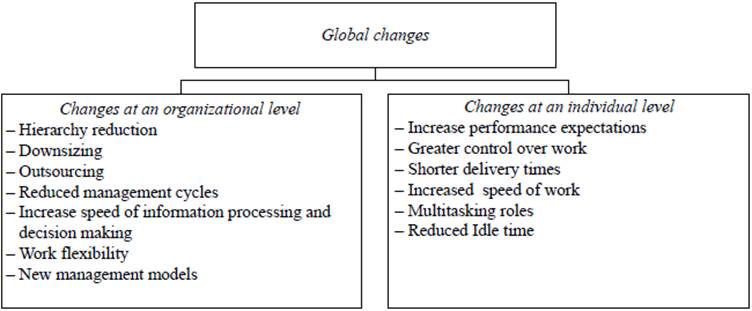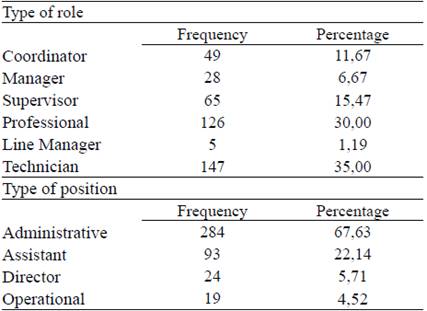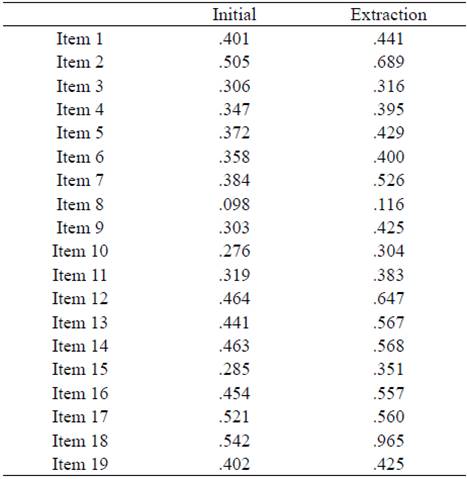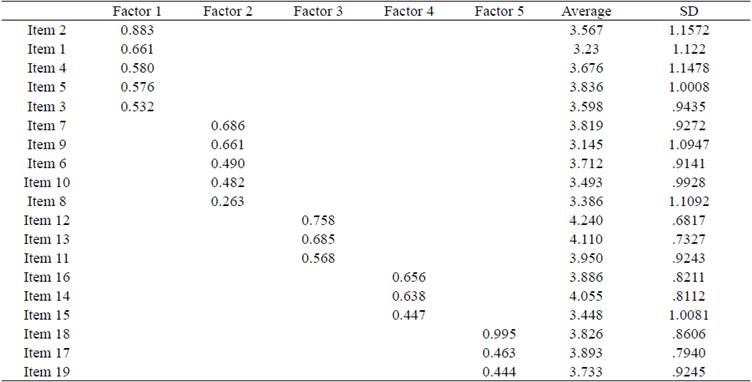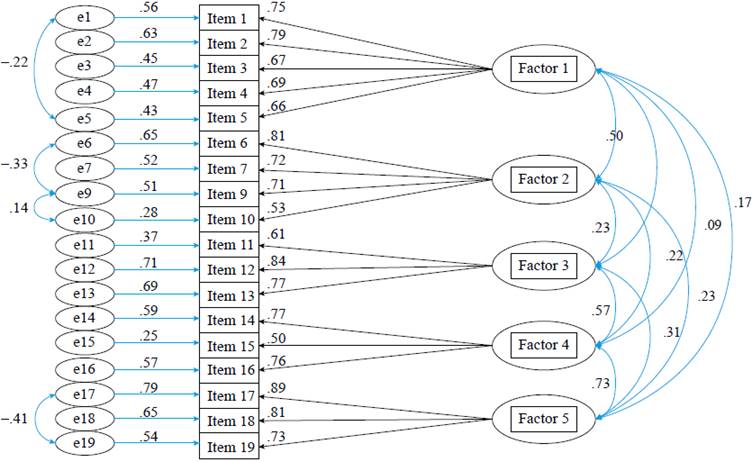Introduction
For managers and professionals who are responsible for managing people in organizations it is of great interest to know the effects that working conditions and characteristics produce in workforce. Understanding, explaining, and even predicting well-being, motivation, and performance levels of an organization's employees has always been an ideal for the disciplines of management, and organizational and work psychology (Paškvan & Kubicek, 2017).
There is enough evidence (Bakker, Demerouti, & Schaufeli, 2003; Bakker, Hakanen, Demerouti, & Xanthopoulou, 2007; Hakanen, Bakker, & Schaufeli, 2006) to show how the characteristics of a task have a profound impact on a worker's well-being. These impacts such as learning, motivation, and commitment to the task and to the organization can be positive; however, some of the characteristics seen as requirements or demands, also produce negative effects on the person such as burnout, emotional stress, and health problems (Franke, 2015; Krause, Scherzer, & Rugulies, 2005; Kubicek, Korunka, & Ulferts, 2013; Lesener, Gusy, & Wolter, 2019).
The world has been facing socio-economic changes, multiple technological advances and a progressive increase in competitiveness among companies; these are factors that inevitably end up both influencing organizational contexts and challenging managers and workers (Kubicek & Kubicek, 2017, p. 28). Figure 1 presents various changes at the organizational and individual levels that have occurred as a result of changes described at a global level.
The shift towards a service-based economy, the transition from closed national economies to global economies, and organizational structures made more flexible - encouraging new management practices, are all representative phenomena of the way the world of work has been since the 1970s. Likewise, it is possible to recognize a key indicator in the process of change: the acceleration of the pace that has been occurring in recent years.
Rosa (2003, 2013) considers that acceleration is one of the consequences of the development of capitalism, and proposes that this is a phenomenon that can be analyzed from a three-dimensional structure: technological acceleration, social acceleration and acceleration of the pace of life. As mentioned previously, the perspective of acceleration of a societal change has effects on people's working life (Flecker, Fibich, & Kraemer, 2017), and especially on their working conditions; therefore adjustments in regards to organizational management cycles, and changes in ways of working have an impact on the demands for carrying out tasks. These aspects require study (Bakker & Demerouti, 2014).
Based on the Job Demands - Resource Model (Bakker & Demerouti, 2007), Franke (2015) proposes that the phenomena associated with acceleration of organizational management rhythms can be contemplated as an intensification of job demands, expressed in higher intensity levels of task development and feelings of having greater time pressure in work contexts; also, Paškvan and Kubicek (2017) define intensification of work as "a multifaceted construct that is characterized by the need to work at increasing speed, for having to cope with shorter response time, to reduce idle time or to perform several tasks simultaneously" (p. 26).
On this matter, searching for increased organizational efficiency presents new ways of working that boost the speed of management cycles, extend the workday, and increase control over performance (Neirotti, 2018). Thus, the intensification of work is operationalized as the increase in physical and cognitive efforts that the individual must progressively expend to perform his or her work (Bathini & Kandathil, 2019) and is reflected in their work pace, pressure to make quicker decisions and the feeling that the workday does not end (Granter, Wankhade, McCann, Hassard, & Hyde, 2019).
As a result of researchers' growing interest in studying this phenomenon, Kubicek, Paškvan and Korunka (2015, pp. 889-900) propose a model for measuring job demands that are subject to intensification. Each of their five proposed conceptual dimensions is detailed below:
Intensification of demands of work effort refers to the increased amount of effort that employees need to invest to do their work. It is the additional pressure that managers put on employees in an attempt to gain a competitive advantage, to shorten management cycles and to increase the decision and production processes speed. Time pressure is positively related to new ways of working implying that work never stops (cf. Kelliher & Anderson, 2008).
Intensification of demands of planning and autonomy at work refers to new organizational logics, by which direct control is reduced and the requirements of autonomous planning and decision making become greater. Due to accelerated changes in management practices, companies have reacted by increasing the speed of decision making and implementing more flexible organizational structures. This generates a new logic of control over people where direct control of managers is reduced and autonomy is increased at all levels (cf., Wood, 2011).
Intensification of demands of career planning is characterized by the increase of the employee's responsibility to take charge of his or her career plan toward the inside and outside of his or her current organization. With hasty changes surrounding them, people are increasingly forced to be key agents of value generation for their organizations and to increase their future employability. In addition, an individual need to work harder to remain attractive to the labor market. This demand is characterized by forcing employees to keep networks updated, and to be open to career opportunities (cf., Briscoe & Hall, 2006).
Intensification of demands for acquiring new learning refers to the increasing pressure to bring employees up to date and to acquire new knowledge related to the world of work. As knowledge represents a key resource in the organizational success and is the basis for competitiveness in a complex world, people are required to update their knowledge more quickly due to technological innovations (cf., Obschonka, Silbereisen, & Wasilewski, 2012).
Finally, Intensification of demands for developing new skills is characterized by an increasing need to develop new skills for handling equipment, applications, processes, methodologies, and also work team management. Learning is not only oriented to knowledge, it has become more demanding and requires people to develop new abilities to do their job well as well as keeping a high level of competences. (cf., Loon & Casimir, 2008).
The increasing acceleration of economic, societal and technological changes that the world of work has been facing causes experiences of task intensification; thereby Kubicek, Paškvan Korunka et al. (2015) construct and validate the Intensification of Job Demands Scale (IDS) to measure the way in which individuals perceive these experiences. According to its authors, the instrument allows direct capture of intensification through the respondent's assessment of whether or not he or she is experiencing an increase in his or her task-related demands, which makes the scale a useful tool for studying the effects of job intensification on workers' health and well-being in their organizational context.
Reviewing specialized literature, there are no other conceptual models or instruments that would evaluate the construct of intensification of demands. As mentioned by Riskin et al. (2015), due to a lack of tools for measuring the phenomenon, data from surveys on working conditions should be used e.g. European Working Conditions Survey (EWCS). There are some instruments that allow evaluation of aspects related to demands or working conditions. Among them are the Job Content Questionnaire (JCQ) by Karaseck (1998), the Effort - Reward Imbalance Questionnaire (ERI) by Siegrist (2004), and the Maslach Burnout Inventory (MBI) by Maslach, Jackson and Leiter (1997). Nevertheless, the Intensification of Job Demands Scale (IDS) is, so far, the only instrument that allows the intensity of change in job demands to be measured.
The scale was originally developed in German and English, and has been used in studies with European populations (Mauno, Kubicek, Minkkinen, & Korunka, 2019; Paškvan , Kubicek, Prem, & Korunka, 2016; Prem, Kubicek, Diestel, & Korunka, 2016; Prem, Ohly, Kubicek, & Korunka, 2017), but so far there is not yet a Spanish version that would allow academics and professionals to apply it in Spanish-speaking organizational contexts.
Therefore, the main objective of this study is to examine the evidence of factor validity and reliability of the instrument from a sample of Colombian workers in order to contribute to the development of research in the area on this relevant topic.
Method
Type of study
The present research was framed as a study of an instrumental type (Montero & León, 2007).
Participants
420 health service members of a private organization, from two different branches participated in the city of Bogotá. Previous research in the sector (Etzion, Eden, & Lapidot, 1998; Moreno-Jiménez & Gálvez Herrer, 2013; Moreno-Jiménez et al., 2009; Sanz-Vergel, Demerouti, Bakker, & Moreno-Jiménez, 2011) has been able to establish negative effects from various factors associated to task and work-related stress demands on people working in this type of organization, so it was found to be appropriate, for the purpose of the research, to use this population framework.
Once the study was approved by the organization's Ethics Committee, a simple random sampling was made to select participants from a total census of 1420 people who had permanent, direct and full-time contracts with the organization. The minimum number required for random sampling was 336, in order to ensure a 95% confidence interval and 5% error level; a final participation of 29.6% was obtained in the two locations.
Participants were between the ages of 18 and 65 (mean = 35.65; SD = 8.88), distributed among 316 women and 104 men (75.2% and 24.8% respectively); work experience varies between 1 and 43 years (mean = 13.74; SD = 8.2); also with various seniority levels ranging from 'new to the job' to 37 years' tenure (mean = 6.36; SD = 5.94). 53.1% of participants reported having leadership over other staff. For administrative positions the profession of the participants was mostly in economic and administrative sciences, and for assistant positions nursing, medicine, and physical therapy.
Table 1 denotes information on the type of role and type of the position.
It should be mentioned that for exploratory factor analysis, a random sample of 200 participants was taken; the remainder of the sample for confirmatory analysis, and the entire sample for reliability analyses.
Instrument
The Intensification of Job Demands Scale (IDS) designed by Kubicek, Paškvan & Korunka (2015), is an instrument that comprises 19 items in a five-point Likert type scale that is set from 'totally disagree' (1) to 'totally agree' (5); it assembles the items in five factors: intensification of work effort (5 items and a=0.91), intensification of planning and autonomy at work (5 items and α=0.90), intensification of career planning (3 items and α=0.82), intensification for acquiring new learning (3 items and α=0.90), and intensification for developing new skills (3 items and α=0.87). The instrument examines the person's assessment of the changes in the demands of his or her work rather than the individual's willingness to adapt him or herself to them.
It should be highlighted that in the original study the penta-factorial structure was found through confirmatory factor analysis, with analysis of rival models and by means of methods of maximum accuracy and authenticity (five-factor model with best goodness-of-fit), obtaining appropriate comparative adjustment indexes (.92 and .96), Tucker-Lewis indexes (.95 and .93), and quadratic error indexes (RMSEA of .067 and .081), factorial invariance analysis with German and Austrian samples (no significant changes in chi-square values for the samples), and reliability analyses with Cronbach's alphas (values between .79 and .94), convergent validity analysis with correlations to scales measuring similar constructs (significant correlations ranging between .43 and .89), discriminant validity with comparisons between groups, and incremental validity with multiple regression analysis.
The English version was selected for the present study, and pertinent analyses were conducted. The Spanish final version of the scale is presented in Appendix A.
Procedure
The research starts, as suggested by Brislin (1970), with a procedure of reverse translation: the items were translated into Spanish and afterwards a group session was held with six experienced Psychology professionals specializing in the field of human resources, who helped review the factors associated with the language and extension of the items. All the items were approved and only small changes in the writing and grammar of the items were suggested to improve the syntactic order and the use of prepositions. Finally, the adapted instrument was translated into English and in order to complete the back-translation process, the equivalence between the versions was proved.
It is important to highlight that, in the interest of maintaining the assessment criterion of intensity of change in the job demands, rather than personal disposition as stated in the original scale, nominal syntagmas (e.g., "increase") were included in each of the items that denote the progression in the change of working conditions.
Endorsements from the Ethics Commissions of both the organization and the academic institution were obtained before the applications. An online format was used for the application of the instrument. A link with the presentation of the study (objectives, participation and ethical conditions), the informed consent and the final adapted scale were sent out by an institutional e-mail.
Data analysis
Once the application with participants was completed, the obtained data were calculated and statistical analyses were carried out, guaranteeing in the first place the conditions and assumptions for the factor analyses proposed by Pérez & Medrano (2010) (elimination of atypical cases with the Mahalanobis extreme distance test, the normality of the variables by revision of the asymmetry and kurtosis of which values had to be less than ±1.5, linearity and interrelations with correlation analyses greater than 0.3 between pairs of items in each subscale; additionally, the Kaiser-Meyer-Olkin test (expected values greater than .7), and the Bartlett's test of sphericity (significance less than .05), and lastly collinearity ensuring that correlations are not greater than .90); and then reviewing construct validity by exploratory factor analysis (performed to observe item-free clustering and not linked to an already pre-designed structure, since there was no factorial evidence in Colombia) with a maximum likelihood in extraction method (chosen because it contains 5 response options and meets the conditions of normality for all the variables to be factored) and an oblique rotation with the Oblimin method (due to factor interrelationship) (Lloret-Segura, Ferreres-Traver, Hernández-Baeza, & Tomás-Marco, 2014), followed by confirmatory factor analysis by structural equation models (SEM) taking into account the following goodness-of-fit indicators: χ2/gl < 3, GFI > .9, AGFI > .9, CFI > .9, TLI > .9, RMSEA < .05 (Brown, 2006). At last, a reliability analysis with general and subscale Cronbach alphas, element-element correlations, total-element correlations, and reliability analysis if each item is hypothetically removed. The R statistical package was used to perform the parallel analysis of Horn, the SPSS version 24 software for exploratory factor and reliability analyses, and the AMOS application for confirmatory factor analysis.
Results
Initially the Kaiser-Meyer-Olkin test and the Bartlett's test of sphericity were used to determine the suitability of the items and their interrelationships for factor analysis. Data shows a KMO of 0.801 and sphericity significance of 0.000, which indicates viability of items and their correlations to support factor analysis. Subsequently, extraction and communalities analysis were conducted for each item. See results in Table 2.
The data shown in Table 2 indicate extraction values greater than 0.3 for all the items, with the exception of item 8; this item is kept for the remainder of factor analysis in order to reveal its viability or eventually deciding to eliminate it. Subsequently, factor analysis was performed, taking into account the criterion of Kaiser's auto-values greater than 1, Horn's parallel analysis, and the original theoretical position of the scale (Lloret-Segura, Ferreres-Traver, Hernández-Baeza, & Tomás-Marco, 2014). Five factors explaining 47.124% of the total variance were found. The items pertinent to each subscale are shown in Table 3.
As shown in Table 3, distribution of the items displays a unique load of each item at a single factor with loads clearly constituted (greater than 0.4) with the exception of item 8; its load, although at a single factor, is less than the expected minimum.
In order to verify the appositeness of the theoretically proposed model in comparison with alternative models, coefficients of the obtained model are shown in table 4, as well as the analysis of rival models with the same model without item 8; along with its similar one with four factors and the elimination of the same item.
Table 4 Coefficients of obtained and rival models, in the structural equation analysis

Note: X2 = Chi-squared; DF = Degrees of freedom; GFI = goodness-of-fit indicator; AGFI = Adjusted goodness-of-fit index; TLI = Tucker-Lewis index; CFI = comparative fit index; RMSEA = Root mean square error of approximation.
As it can be seen, the model with the best fit indicators is the five-factor model, but with the elimination of item 8 - shown in Figure 2.
Regarding internal consistency, a general standardized Cronbach's alpha of 0.808 and 0.818 without items 8 was found; also positive and higher than 0.3 correlations between the items belonging to each factor, and again, except for item 8. Table 5 shows the Cronbach's Alpha obtained for each subscale, correlations between each item and total. The Alpha if the item is hypothetically eliminated; it shows positive correlations greater than 0.4 between each item, and total. Alphas affected by the elimination of the items, with the exception of item 8, which rectifies the need for its elimination. From a theoretical perspective, we consider that by eliminating this item, the instrument doesn't lose the ability to measure the intensification of the level of autonomy in task performance since the other four items of the factor allow for capturing the experience of the individual in the evaluated dimension.
Additionally, with the purpose of evaluating the internal consistency of each of the scale components, Fornell and Larcker (1981) put forward the calculation of the Reliability Composite Score (RCS) for each factor, which takes into account the interrelation between the items, allowing greater consistency and a better reliability measurement. As shown in table 5, Reliability Composite Score (RCS) values exceed 0.70, the limit recommended by literature (Hair, Anderson, Tatham, & Black, 1999).
Discussion
Recent studies have proved that the intensification of demands and requirements in the world of work are becoming ever greater, so it is necessary to manage the effect of the demands on workers and organizations. Therefore, it is important to have optimal, valid and reliable evaluation and measurement instruments for an adequate diagnosis and subsequent intervention in the organizational contexts.
The results of this study showed that the Spanish version of the scale presents a five-factor model which clearly explains 47.124% of the total variance, with a grouping of items similar to the original theoretical proposal with high consistency and reliability coefficients; however, for this version of the instrument the elimination of item 8 is recommended.
These findings are similar to those found in the study of the scale design (Kubicek et al., 2015); they also find the same penta-factorial structure with the same distribution of items, goodness-of-fit index and similar reliability indicators that reaffirms the equivalence of the construct, and gives additional evidence to demonstrate that the scale is a valid and reliable measure; in view of the above, measurement of task and work intensification of demands is evaluated in Spanish-speaking business contexts. The literature is nevertheless, limited for comparing these findings due to the newness of the scale and the construct existence at the present time.
It is worth noting that although the sample size was sufficient to support the statistical analyses, the present study has some limitations. Among them, it is established that the study does not represent the population unit as a whole because the sample belongs to a single organization, and it is mainly composed of women (75.2%); therefore it is recommended to replicate the search with larger samples and greater population diversity. Likewise, the sample was obtained from only one economic sector, so it is suggested to replicate the search with samples from other business sectors. Lastly, it is difficult to compare the results because to date no other studies have been carried out in the region to analyze their psychometric properties, so replication in other contexts and countries is suggested as a future line of research.
In conclusion, it is confirmed that the Spanish version of the Intensification of Job Demands Scale (IDS) is a valid, consistent and reliable scale to directly evaluate the construct, so utilizing it is recommended to measure new demands that might emerge in the world of work due to social acceleration; also to evaluate the perception of change in working conditions of a particular context and to study the effects associated with the acceleration of management rhythms on the workers' health and well-being in an organizational context.











 text in
text in 

